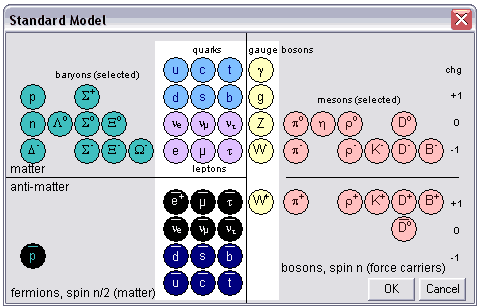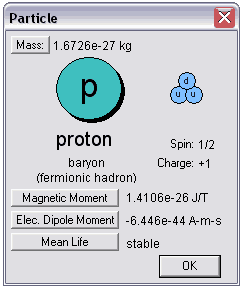Particle Physics
The view of atoms as electrons orbiting a nucleus as the planets orbit the sun is not an accurate one. The temptation is to think of electrons, protons and even photons as behaving like miniature billiard balls. But the at subatomic scales this kind of understanding based on everyday experience simply does not work. These particles have no definite position and it is more useful to think in terms of probability distributions or wave functions. Their existence must be deduced from subtle interactions with other particles and the detectors physicists use to study them.
In this way, physicists have discovered whole families of fundamental particles, most of which exist only fleetingly, and which are able to transform into each other provided that energy, spin, charge and other properties are conserved. The Standard Model is a theoretical framework used to organise and understand these fundamental particles; the quarks, gauge bosons and leptons (which include the electron). They can be categorised graphically in an analogous way to the Periodic Table of elements, with each row having the same charge (photon and gluon excepted) and each column representing the three generations of matter and the force carriers. Other particles, called hadrons, are made up of quarks in groups of two (mesons, containing a quark/antiquark pair) or three (baryons). The neutron and proton are types of baryon.
You can see a representation of the Standard Model, together with a selection of hadrons using the Particles option from the Tools menu.

Fermions are on the left of the vertical line (spin 1/2, 3/2 etc.). These are matter constituents. To the right of the vertical line are the Bosons (particles with integer spin) which are force carriers. On palm-size format devices you can view either fermions or bosons at any one time. The fundamental particles comprising the Standard Model are in the white area. The particles are arranged vertically according to their charge. The charge of each row, excepting the quarks and gluon, is indicated at the right hand side in units of elementary charge. The quarks are also grouped in rows of equal charge of 2/3 and -1/3.
All particles have corresponding anti-particles where properties such as charge are reversed. Particles and their antiparticles can also be thought of as being the same entity travelling in opposite directions in time. The antineutrinos have the same properties as the neutrinos but their spin direction with respect to the direction of travel is reversed (i.e. opposite handedness). Some particles, such as the photon, do not have distinct anti-particles, or rather they are their own anti-particles. The right-hand horizontal line separates the matter (from which the Universe is almost entirely made) and anti-matter. The antimatter particles are shown with inverted colours.
The bosons are lined up with particles opposite their corresponding anti-particles. A horizontal line divides them, but there is no definitive way of saying which is the "particle" and which the "antiparticle". Particles on either side of the line should simply be regarded as anti-particles of each other, for example the pi+ and pi- (which are conventionally referred to as pion and anti-pion). The pi0 is its own antiparticle because it consists of an up/anti-up quark pair.

You can click on a particle to get more information about it. In the case of mesons and baryons the constituent quarks are also shown. In the example the proton can be seen to be one of the few stable particles. The properties of the particle can be entered into the calculator by clicking on the buttons. It can also be seen to be made of a down quark and two up quarks. The quarks are bound together by the strong nuclear force, mediated by gluons. The strong nuclear force is so great that it is not possible to separate the quarks so that they can exist independently. The energy of pulling them apart is enough to cause more quarks to snap into existence which then decay into other particles.
Excellent introductions to Particle Physics and the Standard Model can be found in the Particle Physics Adventure.